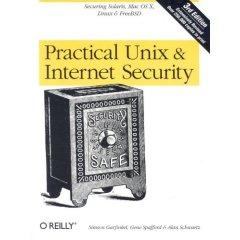| 2020ok Directory of FREE Online Books and FREE eBooks |
Free eBooks > Computers & Internet > Web Development > Security & Encryption > Encryption > Practical Unix And Internet Security 3rd Edition
Practical Unix And Internet Security 3rd Editionby Simson Garfinkel, Gene Spafford, and Alan Schwartz  Download Book If you are the author or the publisher, and would like to link to your site here, please contact us. About Book Amazon.com The world's most business-critical transactions run on Unix machines, which means the machines running those transactions attract evildoers. Furthermore, a lot of those machines have Internet connections, which means it's always possible that some nefarious remote user will find a way in. The third edition of Practical Unix & Internet Security contains--to an even greater extent than its favorably reputed ancestors--an enormous amount of accumulated wisdom about how to protect Internet-connected Unix machines from intrusion and other forms of attack. This book is fat with practical advice on specific defensive measures (to defeat known attacks) and generally wise policies (to head off as-yet-undiscovered ones). The authors' approach to Unix security is holistic and clever; they devote as much space to security philosophy as to advice about closing TCP ports and disabling unnecessary services. They also recognize that lots of Unix machines are development platforms, and make many recommendations to consider as you design software. It's rare that you read a page in this carefully compiled book that does not impart some obscure nugget of knowledge, or remind you to implement some important policy. Plus, the authors have a style that reminds their readers that computing is supposed to be about intellectual exercise and fun, an attitude that's absent from too much of the information technology industry lately. Read this book if you use any flavor of Unix in any mission-critical situation. --David Wall Topics covered: Security risks (and ways to limit them) under Linux, Solaris, Mac OS X, and FreeBSD. Coverage ranges from responsible system administration (including selection of usernames and logins) to intrusion detection, break-in forensics, and log analysis.
The publisher, O'Reilly and Associates When Practical UNIX Security was first published in 1991, it became an instant classic. Crammed with information about host security, it saved many a UNIX system administrator and user from disaster. This second edition is a complete rewrite of the original book. It's packed with twice the pages and offers even more practical information for UNIX users and administrators. In it you'll find coverage of features of many types of UNIX systems, including SunOS, Solaris, BSDI, AIX, HP-UX, Digital UNIX, Linux, and others. The first edition was practical, entertaining, and full of useful scripts, tips, and warnings. This edition is all those things -- and more. If you are a UNIX system administrator or user in this security-conscious age, you need this book. It's a practical guide that spells out, in readable and entertaining language, the threats, the system vulnerabilities, and the countermeasures you can adopt to protect your UNIX system, network, and Internet connection. It's complete -- covering both host and network security -- and doesn't require that you be a programmer or a UNIX guru to use it. Practical UNIX & Internet Security describes the issues, approaches, and methods for implementing security measures. It covers UNIX basics, the details of security, the ways that intruders can get into your system, and the ways you can detect them, clean up after them, and even prosecute them if they do get in. Filled with practical scripts, tricks, and warnings, Practical UNIX & Internet Security tells you everything you need to know to make your UNIX system as secure as it possible can be. Contents include: Part I: Computer Security Basics. Introduction and security policies. Part II: User Responsibilities. Users and their passwords, groups, the superuser, the UNIX filesystem, and cryptography. Part III: System Administrator Responsibilities. Backups, defending accounts, integrity checking, log files, programmed threats, physical security, and personnel security. Part IV: Network and Internet Security: telephone security, UUCP, TCP/IP networks, TCP/IP services, WWW, RPC, NIS, NIS+, Kerberos, and NFS. Part V: Advanced Topics: firewalls, wrappers, proxies, and secure programming. Part VI: Handling Security Incidents: discovering a breakin, U.S. law, and trust. VII: Appendices. UNIX system security checklist, important files, UNIX processes, paper and electronic sources, security organizations, and table of IP services. Related Free eBooks
| Related Tags |












SEND A COMMENT
PLEASE READ: All comments must be approved before appearing in the thread; time and space constraints prevent all comments from appearing. We will only approve comments that are directly related to the article, use appropriate language and are not attacking the comments of others.